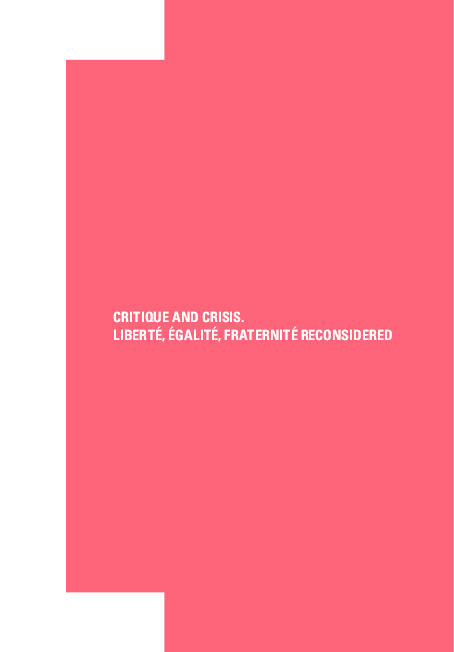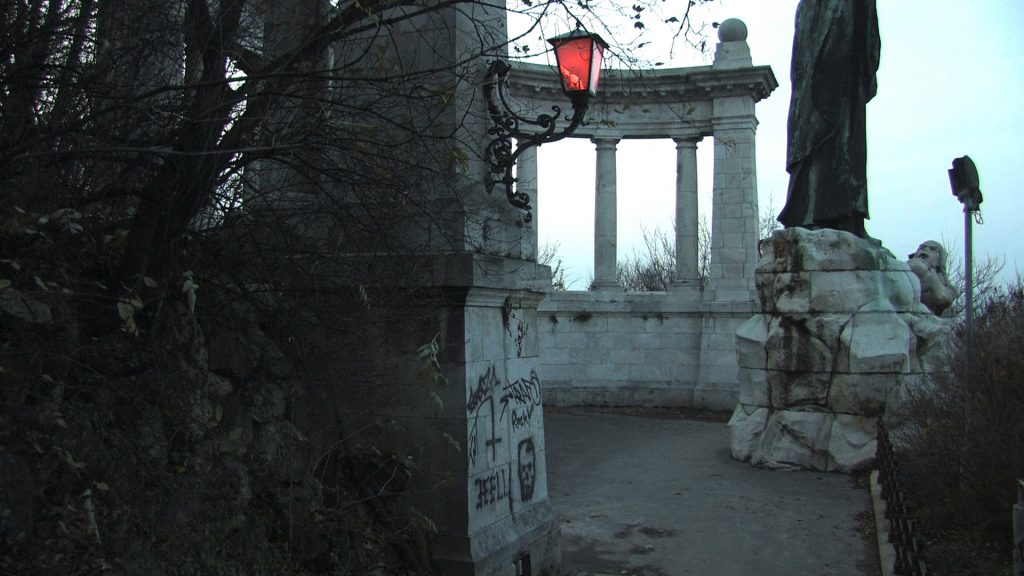Critique and Crisis
Liberté, Égalité, Fraternité reconsidered
(1)

Related Works
Kata Krasznahorkai
2015
Publisher
Contributors
Texts by Georgios Papadopoulos, Kata Krasznahorkai, Zsolt PálfalusiWe are artistsWe are mathematicians (…)But we are tired We are hardly breathing And we‘re freeWe’re sick and tired (…)We got nothing to believe in We are lost (…)We are deceiving (…) Go tell the women that we‘re leaving (Excerpts from: Grinderman – Go Tell The Women; Writer(s): Nicholas Edward Cave, Warren Ellis, Martyn Casey, James A. Sclavunos Copyright: Embassy Music Corp. O/B/o Mute Song Lyrics)When addressing artists with the question about their ideas on “liberté, égalité, fraternité” we have been confront-ed with irritation, scepticism, resignation and distrust – back in 2012, when the project CRITIQUE AND CRISIS started. The relevance and explosivity of these terms seemed to be relat-ed only to official openings and to the rhetorics of European cultural politics. But after the 2015 attacks in Paris, the whole of Europe experienced in a truly horrifying scenario that these terms are not empty phrases at all. To listen to artists and to ask about their role in the state of permanent crisis started to be more and more our issue.The programme series CRITIQUE AND CRISIS ques-tioned over the span of three years between 2012-2015 the last common denominator of European crisis philosophy, namely, the basis of a democratic order that still holds today. But what is left of liberté, égalité, fraternité? The goal of the series was to see how these basic principles of the shared European iden-tity measure up to Europe’s current self-image from the per-spective of artists.With exhibitions, talks, symposia, catalogues and an art education programme for children we addressed the questions surrounding liberté, égalité and fraternité. The first exhibition of the series, VERTIGO OF LIBERTÉ (18.10.2012–20.01.2013), was made up mainly of video works and explored the dark side of freedom; the subsequent exhibition, SPECTRES OF ÉGALITÉ (15.11.2013–19.01.2014), questioned the relevance of the next basic democratic principle: equality. The series came to an end with the 2014/15 exhibition, which took the ORNAMENT OF FRATERNITÉ (13.11.2014–18.01.2015) in today’s Europe as its subject.The goal of the CRITIQUE AND CRISIS project was to re-veal the diversity, contradictions and conflicts within the con-ception of the European self-image. We wanted to strengthen and draw attention to the Eastern European perspective on these ideas. Situations of crisis play a crucial role in the disso-lution of existing structures and the creation of new ones. This is precisely the point at which CRITIQUE AND CRISIS gets to work as it opened up a space for examining and reflecting on our own preconceived notions and prejudices.The CRITIQUE AND CRISIS project was unique because it has been able to explore the same fundamental questions for three years, during which time it has, in all its nuances, been shaped by various changes. Our main priority was to deal with artistic positions, and we make it a point to avoid forcing these into any single overarching theory. So the strength of CRITIQUE AND CRISIS lies in the way it asked about the crisis in the crisis on a visual level. The idea of Europe became com-mon currency in the language of images. We were asking critical questions in the crisis about the crisis and beyond the crisis. The result is this publication, which is a kind of anthological survey. We decided to repro-duce all three exhibitions and all the works that were presented in this catalogue along with the original introductory remarks by the curators of the exhibitions so that the historical dimen-sion remains part of this publication. But we also wanted to reflect on our actual positions, thus we commissioned an es-say by the Greek economist and philosopher GEORGIOS PAPADOPOULOS on the critical potential of art and on the role of artists in the state of permanent crisis. To widen the horizon of perception we translated and reproduced a fascinating text by the Hungarian philosopher ZSOLT PÁLFALUSI, who has envisioned a new role for philosophy as a performative gen-re which should provide key competences to deal with crisis situations. The scepticism against the European Idea as such was the topic of a lecture held by the project manager KATA KRASZNAHORKAI at the conference “The European Idea in Art and Art History after 1945”, organized by the German Histori-cal Museum and the Collegium Hungaricum Berlin in Septem-ber 2014; this lecture is reprinted here as well. We conceived the corporate identity, the graphical solutions and visual ideas manifest in this book from the beginning as a constituting and autonomous part of the project, which has its own narrative and is the work of the artist IMRE LEPSÉNYI.CRITIQUE AND CRISIS arose out of a series of conversa-tions with Monika Flacke, Henry Meyric Hughes, Irene Weide-mann and the representatives of partner institutions in Kraków, Tallinn, Milan and Prague about the concept of the 30th Coun-cil of Europe Art Exhibition, “The Desire for Freedom. Art in Europe since 1945”, which provided the broader framework of the programme. I would like to express my gratitude to all the artists who contributed to this exhibition – with their own work and their reflections. Furthermore I would like to thank the European Commission and the Council of Europe for the generous support as well as the whole team of the Collegium Hungaricum Berlin. I am convinced that although the CRITIQUE AND CRISIS programme ended, the state of crisis is ongoing – forever. And the only one who can tell, are the artists – don`t let them leave.Kata Krasznahorkai May 2015

